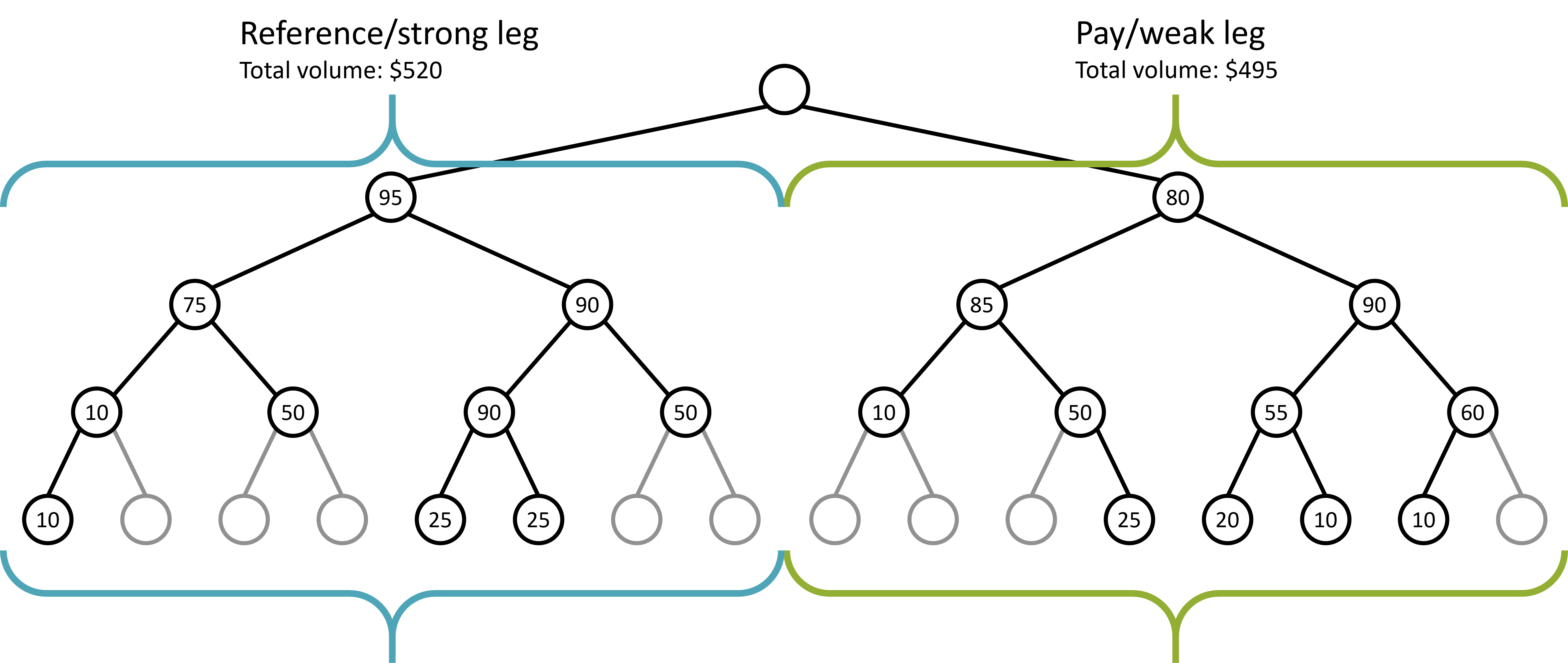SHARE
What’s a pay leg commission?

Pay leg commissions are built on a simple concept. Typically, binaries use one of two systems to pay distributors, cycle bonuses or pay leg commissions. In this article we discuss the pay leg commission type. Pay leg commission deliver the the primary commission in binary plans, and they are only used in binary plans. They are excellent at guaranteeing that the payout goes to the distributors who are building their organizations.
How pay leg commissions work
Based on company policies, one or more dowline nodes exist for each distributor or centers. Each of these nodes has two downline legs; a reference leg (also known as the strong leg) and a pay leg (or weak leg). As the alternative names suggest, the weak leg generates less volume and the strong leg generates more. Distributor pay comes from volume generated in his or her pay leg. The pay leg pays to unlimited depth—no other commission works this way. Companies pay the distributor a certain percentage—usually 10%—on literally all of the volume generated in his or her pay leg(s).

In this chart, the distributor at the top of the tree can expect a commission of $49.50—10% of $495. The ease with which a distributor can calculate their percentage is one of the draws of a binary. Distributors know the exact value of each additional downline sale they make.
Balancing your downline legs
As a binary distributor, your objective is to balance the volume in your two downline legs. If the distributor depicted above had $520 of volume in both legs, he would earn $52. If one of his two legs grew beyond that while the other stayed the same, he would still earn $52. If your legs have equal volume, you have maximized your payout.
The pay leg/reference leg designations are not static, so if someone in one side of your organization starts taking off—recruiting heavily and growing the leg in which they reside—and if everything else stays the same, that leg will become your reference leg. Alternatively, if a heavy hitter in your reference leg leaves the organization, over time that leg may decline and become your pay leg. When you recruit new distributors, you want to place them in your pay leg.
Commission caps
However, there’s always a maximum company-wide payout (or cap) associated with pay leg commissions. If there wasn’t, it would be possible for commissions to payout more than 100% because of the unlimited depth on volume.
Most successful companies (binary or otherwise) pay somewhere between 50–40%. This is the range at which commissions can remain sustainable for the company. There are different ways that binaries stay in that range, but it’s usually preferable for a company to cap secondary commissions—bonuses paid in addition to the pay leg bonus—rather than the pay leg commission itself. The reason for this is the simplicity of calculating that 10%. Distributors will know if they’re receiving less than 10% on their pay leg and that 10% is—from the distributor’s perspective—a key benefit of a binary plan.
Pros
Understandable
Although sometimes the details can become murky, the core concept of pay leg commissions is simple to explain and understand.
Unlimited pay depth
A company pays on unlimited depth of volume up to a maximum amount. One way that companies limit is to cap the amount paid out by rank. Distributors may “stack” their downline without hurting the company. Volume may exist on 1 level or 500 levels away, and the distributor still gets paid on that volume.
Cons
One percentage
Pays a flat percentage based on volume. There is no money in the commission to incentivize salespeople for taking care of their customers because they’re outside of the tree and thus outside of the pay leg. Companies get around this con by adding other bonuses that pay on personally enrolled tree such as a customer bonus.
No urgency once they’re in
Sometimes distributors get the idea that they don’t have to work in a binary plan because the the reference leg carries forward any unused volume.
Summary
The pay leg commission is the primary commission for the binary compensation plan. In the past, people saw this plan as the “new kid on the block,” but binary has taken its place as an industry standard and doesn’t seem to be going away any time soon.
Want help designing a pay leg commission? Reach out to us at MLM Compensation Consulting. We offer data-driven compensation plan design and analysis.
This article is an adapted excerpt from Mark Rawlins’ book From Commission Plan to Compensation Strategy. Give it a read if you want even more information about commissions and how they come together in compensation plans.
you may also like
Essential Software Customizations for MLM, Direct Selling, and Affiliate E-commerce
Navigating the changing landscape of e-commerce, particularly within MLM, direct selling, and affiliate marketing channels, requires more…
How to Ensure Your Compensation Plan and Software Work Well Together
Peanut butter and jelly. Milk and cookies. Batman and Robin. Everybody knows these famous pairings work well…
Podcast 53: Advantages Using an Interim VP of Sales for Direct Selling Companies
Today we welcome a returning guest of this podcast: Jeff Jordan. Jeff has also written articles for…
compensation consulting for mlm companies
We offer data-driven compensation plan design & analysis
MLM.com Newsletter
Get our e-mail newsletter, with MLM.com articles & online exclusives, delivered to your inbox each week.



